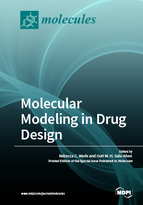Molecular Modeling in Drug Design
A special issue of Molecules (ISSN 1420-3049). This special issue belongs to the section "Medicinal Chemistry".
Deadline for manuscript submissions: closed (31 May 2018) | Viewed by 97062
Special Issue Editors
Interests: molecular modeling and simulation; protein-ligand interactions; molecular recognition; structure-based drug design
Interests: computer-aided drug design; molecular dynamics simulations; anti-virulence agents; antibacterials; natural compounds
Special Issues, Collections and Topics in MDPI journals
Special Issue Information
Dear Colleagues,
Since the first attempts at structure-based drug design about four decades ago, molecular modelling techniques for drug design have developed enormously, along with the increasing computational power and structural and biological information on active compounds and potential target molecules. Currently, molecular modeling can be considered an integral component of the contemporary drug discovery and development process. Rational target-based drug development projects benefit significantly from understanding the essential ligand-receptor interactions for designing a potent and efficacious drug to the desired target.
Although current modeling techniques can give important insights and speed up the drug discovery and design stages significantly, there are still many challenges in, for example, predicting accurate ligand binding energies, considering protein flexibility upon ligand binding, or mapping off-target effects of designed compounds. Nowadays, there is also a need for modelling bigger entities, such as antibodies and nanoparticles, as well as targeting macromolecular interfaces.
The aim of this Special Issue is to present a contemporary overview of recent developments in the field of molecular modeling in the context of modern drug design. Reviews, full papers, and short communications, covering the methodological and theoretical aspects of the current trends in molecular modeling are all welcome. The submission of papers addressing the topics listed below is particularly encouraged.
Prof. Dr. Rebecca WadeProf. Dr. Outi Salo-Ahen
Guest Editors
Manuscript Submission Information
Manuscripts should be submitted online at www.mdpi.com by registering and logging in to this website. Once you are registered, click here to go to the submission form. Manuscripts can be submitted until the deadline. All submissions that pass pre-check are peer-reviewed. Accepted papers will be published continuously in the journal (as soon as accepted) and will be listed together on the special issue website. Research articles, review articles as well as short communications are invited. For planned papers, a title and short abstract (about 100 words) can be sent to the Editorial Office for announcement on this website.
Submitted manuscripts should not have been published previously, nor be under consideration for publication elsewhere (except conference proceedings papers). All manuscripts are thoroughly refereed through a single-blind peer-review process. A guide for authors and other relevant information for submission of manuscripts is available on the Instructions for Authors page. Molecules is an international peer-reviewed open access semimonthly journal published by MDPI.
Please visit the Instructions for Authors page before submitting a manuscript. The Article Processing Charge (APC) for publication in this open access journal is 2700 CHF (Swiss Francs). Submitted papers should be well formatted and use good English. Authors may use MDPI's English editing service prior to publication or during author revisions.
Keywords
- Advanced molecular simulation techniques
- Big data analysis
- Molecular dynamics simulations
- Quantum mechanics
- Chemoinformatics
- Water in binding sites
- Cryptic binding pockets
- Drug binding kinetics
- Covalent inhibitors
- Off-target prediction
- Protein-protein interaction inhibitors
- Antibody design
- Nanoparticles








